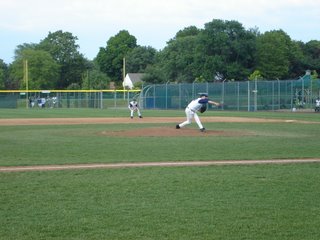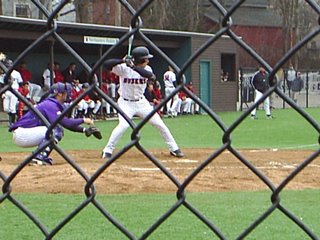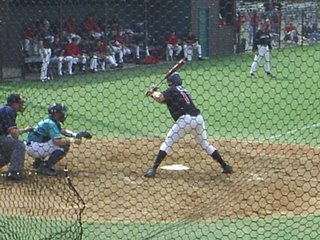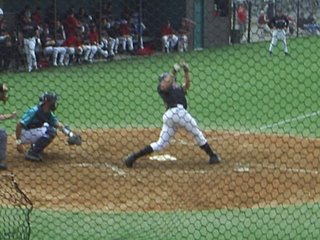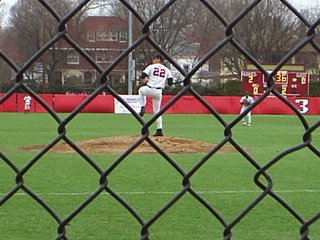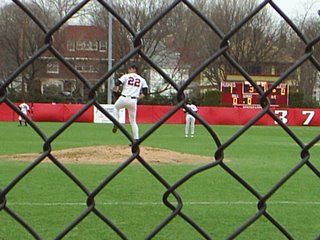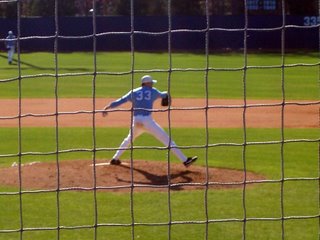



Jeff Samardzija, Notre Dame, Junior
Righthanded pitcher 6'5", 216
1/23/85
2006 regular season stats:
4.30 ERA 7-2 13 GS 81.2 IP 85 H 34 BB 52 K .275 BAA 1 HR
I wandered over to Plymouth Meeting, PA on a sunny May afternoon to catch the Notre Dame-Villanova Big East matchup. The game drew a season high number of fans (591) to Villanova Stadium, a crowd no doubt bolstered by the dozens of scouts in attendance there to check out the starting pitching duel of Jeff Samardzija and Kevin Mulvey. The Notre Dame lineup had a couple of intriguing bats, but the most impressive hitter on Irish was 1B Craig Cooper. The Villanova lineup featured some interesting bats in its own right, but the most exciting swing belonged to their 1B Jeremy Hunt. The other top prospect on the two rosters was not scheduled to pitch, but is still a worthwhile enough talent to merit background information on – that would be Notre Dame SP Jeff Manship. Those five names made up the best draft eligible talent in the ballpark, but the Notre Dame roster featured a couple of underclassmen with the potential to make a little bit of noise in future drafts.
Some of the teams with multiple scouts in attendance included the Phillies (obviously), the Yankees, the Nationals, and the Rangers. The Phillies contingent included regional scout, former big leaguer, and Villanova alum Gene Schall not to mention special assistants to the general manager John Vukovich and Dallas Green. The Yankees and Nationals both had a large number of scouts watching closely – it seems logical that these two teams could be potential landing spots for Samardzija (Yankees with the cash to lure him away, Nationals with the new ownership group and the desire to make a splash). I also heard rumors that Samardzija’s football coach Charlie Weis was in the house, but I never actually saw him so I can neither confirm or deny (though I want to believe he was there as his presence would have made the whole event even more of a big deal than it already was).
Repertoire: Samardzija threw a darting four seam fastball (sitting in the low 90s today, though it reportedly peaked at 96 MPH earlier this spring), a slider that showed promise but still needs a good bit of work and the occasional off-speed pitch – reports claim that it is a changeup, but I swear I also saw him toss a handful of very slow curveballs (I haven’t seen this reported anywhere else, so I may have just been seeing things). Judging by the way he was using his slider today made it seem as though he wasn’t all that confident in his ability to get it over for strikes. Then again, maybe he simply realized early on in the game that his fastball was working for him and he wouldn’t even have to bother with throwing his secondary pitches as much.
Mechanics: This is an area where I am way out of my league in evaluating, but I’ll give it my best shot; normally I can’t really figure out the plusses and minuses of a given player’s windup, throwing motion, or batting stance, but Samardzija’s unusual delivery made it easy to spot the differences between his mechanics compared to a more traditional, classic baseball player windup (take Mark Prior’s motion for example). Anyway, Samardzija is funky out on the mound…and, judging by the reaction of the scouts standing by me, he isn’t necessarily funky in a good way. He is a short strider with a suspiciously low leg kick. The way he sets his hands was strange to see as well – they were lower than almost any other pitcher I’ve ever seen. His pickoff move was also pretty ugly to watch – so ineffective that it wasn’t even keeping runners close. However, it should be noted that nobody ran on him…although it wasn’t as if there were many Wildcats who reached base and even got the chance to think about running. The last, and arguably most important qualm about his mechanics I noticed, was the varying arm slot he used from pitch to pitch. His delivery was not one that any scout would call smooth and he seemed to have trouble getting into a repeatable groove. His mechanics deteriorated even further as the game moved on. Again, I should point out that he was excellent today, so these concerns of mine may be totally baseless. I still would not hesitate to call him a “raw” college arm based on what I saw today – good coaching in the minor leagues will make or break him, but there is plenty of natural talent with which to work.
On the mound, Samardzija was all business – the expression on his face did not change all afternoon. I overheard some scouts talking about this and they seem concerned that his emotionless strut off the field after each half inning was a sign that he didn’t get along with his teammates – he barely acknowledged his mates as they came out to high five him. This is obviously reading way too much into a very minor thing, but it was discussed by the scouts in attendance so I figured it couldn’t hurt to add it in. personally, I liked his stoic mound presence and unflappable demeanor. That being said, I do see how a scout could be concerned that Samardzija hasn’t really become a true member of the baseball team because of his many football commitments. This is something that can be cleared up by talking to members of his team…something scouts have far more access to that a wannabe like me.
Approach: The one thing that stood out above everything else for me about Samardzija’s game was his ability to throw a first pitch strike. Unfortunately I did not record this while watching so I don’t have the numbers to back it up, but it really seemed that he was getting his four seamer over to about three fourths of every hitter (a totally random guess on my part). Samardzija was working ahead all game and the Villanova hitters (outside of Jeremy Hunt) never seemed to be able to work themselves into hitter’s counts. Hunt was the only Wildcat to hit the ball hard off of Samardzija all day long. This is a testament to Samardzija’s ability to get ahead in the count and consistently pipe low fastballs by the overmatched opposition. Everything was down in the zone for Samardzija today – he was hitting his spots with tremendous precision (the umpire was calling a very low strike all day and both Samardzija and Nova starter and possible first rounder Kevin Mulvey were using it to their advantage) and his control as a whole was excellent. Samardzija only got in real trouble one time – first and third with nobody out in the fifth inning (after a dropped third strike on a K and an error). Samardzija got out of the jam unscathed after getting a double play (just the everyday 5-3-2 DP) and a flyball out. It was rather impressive to see him work himself out of a tough jam that he himself had no part in getting in – give him a plus for mental toughness on the mound.
Samardzija’s final line was impressive: 8.1 IP 5 H 1 ER 0 BB 7 K - by my count, he got 14 ground ball outs, 4 fly ball outs, and 7 strikeouts (109 total pitches). I must admit, I came into the game with a ton of doubts about all the hype surrounding Samardzija. I thought he might just another guy who gets high expectations pinned on him as the rare athlete that can potentially excel at two professional sports. I was wrong – forget the football hype, Samardzija is a legitimate prospect based on what he can do on the diamond. He has a live arm, stays low in the zone, induces a good number of ground balls (I know it was just one game’s worth of data – I’m hoping to go through some box scores and figure out the GO/FO ratio for him and some other top college prospects before the draft), and shows enough with his secondary pitches to project as a potential big league starter. He is listed at 6’5’’ on both his baseball and football bios, but I’m not sure he is that tall – I’d say he is closer to 6’3’’ than 6’5’’ (again, just one onlooker’s estimate), but what’s a couple of inches between friends? His frame is long and lean (a plus), but his mechanics are shaky at best (an obvious negative). He is far from the perfect prospect, but his raw talent can not be questioned. He isn’t the typical college star pitcher that can be moved quickly to the bigs (he is no Tim Lincecum), so any team drafting him will have to be patient with his development. Jeff Samardzija should be a major leaguer some day (if that is the path he so chooses…) who will be drafted within the first three rounds of the MLB draft this June.
As far as football goes, I believe he is the top wide receiver in the senior class. Once you add Georgia Tech’s Calvin Johnson and USC’s Dwayne Jarrett, things get a bit more crowded at the top, but he is still a player with as good a shot as any to be a first round pick in the 2007 NFL draft. I have no idea what path Samardzija will end up taking, but I think we can all agree that discussing the pro-baseball/pro-football sides of the argument will help liven up the MLB draft this year.
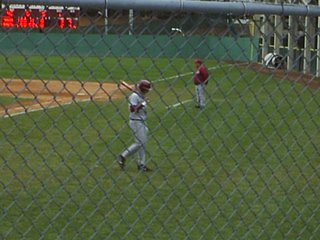
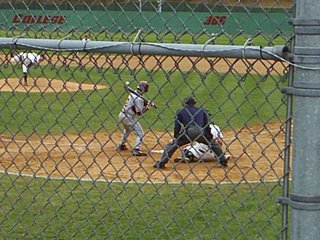
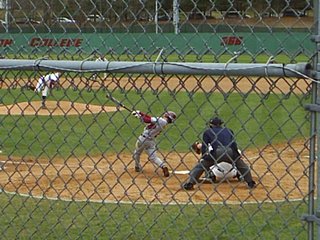
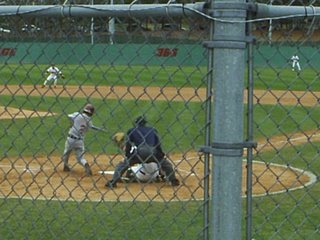 Shane Robinson –
Shane Robinson – 


 Tyler Chambliss –
Tyler Chambliss – 
 Ryne Malone –
Ryne Malone – 